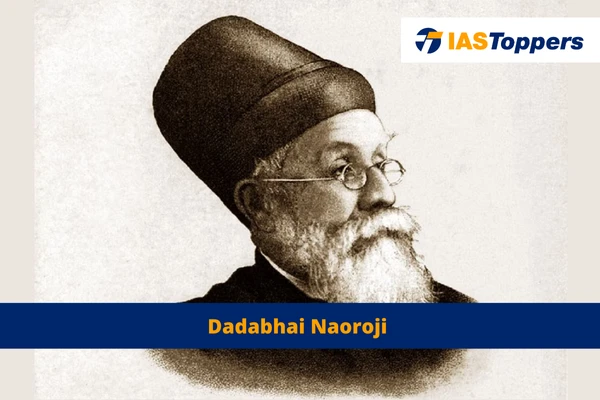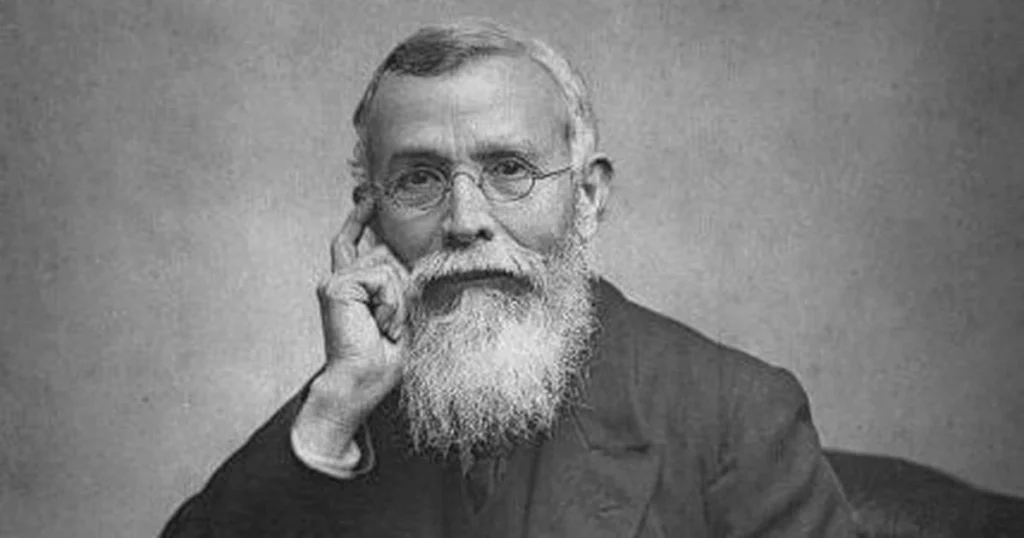Dadabhai Naoroji, also known as the ‘The Grand Old Man of India,’ was born into a priestly Parsi family in Bombay on 4 September 1825. He was a prominent Indian nationalist and social reformer. His belief in parliamentary democracy, advocacy for women’s education, and pioneering work in assessing India’s national income earned him recognition in the field of Indian economic thought.
Dadabhai Naoroji will be helpful for UPSC IAS Exam preparation. GS Paper-1 History.
Table of Content
- Who was Dadabhai Naoroji?
- Contribution and Achievements
- Drain Theory
- Conclusion
- Frequently Asked Questions (FAQs)
Who was Dadabhai Naoroji?
- He was born into a priestly Parsi family in Bombay on 4 September 1825.
- Naoroji received a liberal Western education.
- He appreciated the Western system of education.
- In India, he had friends from various walks of life, including social reformer Sorabjee Bengali, Khursetji Cama, Kaisondas Mulji, K. R. Cama, Naoroji Furdoonji, Jamsedji Tata, and Indian Princes.
- Among his younger associates were R. G. Bhandarkar, N.G. Chandavarkar, Pherozeshah Mehta, G. K. Gokhale, Dinshaw Wacha, and M. K. Gandhi.
- He firmly believed in the principles of parliamentary democracy.
- He gained recognition in the field of Indian economic thought for his pioneering work in assessing the national income of India.
- Naoroji played a leading role as a social reformer during the latter half of the 19th century.
- He vehemently opposed caste restrictions and advocated for women’s education and gender equality.
- While deeply committed to his Zoroastrian faith, Naoroji maintained a broad-minded perspective and formed friendships with non-Parsis such as Hume, Wedderburn, Badruddin Tyabji, Dr Bhau Daji, K. T. Telang, and G. K. Gokhale.
- In his book ‘The Duties of the Zoroastrians,’ he emphasized the importance of purity in thoughts, speech, and actions.
- As a prominent nationalist with progressive views, he aligned himself with the moderate faction and staunchly believed in constitutional methods.
- Despite being an advocate for Swadeshi (Indian self-sufficiency), he recognized the value of utilizing machinery to organize crucial industries in the country.
Contribution and Achievements
- He earned the prestigious Clare Scholarship as a result of his exceptional performance at Elphinstone College.
- After graduating in 1845, he became the first Indian Professor at Elphinstone College, where he taught special classes focusing on women’s education.
- In 1855, Naoroji departed for London and joined Cama & Co., the first Indian company established in the city.
- Later, he established his own firm, Naoroji & Co.
- Four years later, he assumed the position of Professor of Gujarati at University College London.
- In 1867, Naoroji founded the East India Association in London, aiming to present the Indian viewpoint to the British public.
- It is an organization that played a precursor role in the establishment of the Indian National Congress.
- In 1874, he was appointed as the Dewan of Baroda.
- He resigned a year later due to disagreements with the Maharaja and the Resident.
- In July 1875, he was elected as a Member of the Municipal Corporation in Bombay but resigned and returned to London in 1876.
- In 1883, he was appointed as a Justice of the Peace and started a newspaper called ‘Voice of India’.
- In August 1885, he served a second term as a Member of the Bombay Municipal Corporation and joined the Bombay Legislative Council at the invitation of the Governor, Lord Reay.
- Naoroji became one of the Vice-Presidents of the newly formed Bombay Presidency Association on 31 January 1885.
- He played a leading role in the establishment of the Indian National Congress at the end of the same year, serving as its President in 1886, 1893, and 1906.
- In 1902, he made history by being elected as a Member of the Liberal Party in the House of Commons, representing Central Finsbury, and becoming the first British Indian Member of Parliament.
- His character and personality were significantly influenced by his foreign travels.
- He founded several important organizations and held memberships in various prominent societies and institutions in India and the U.K., including the Indian National Congress, the East India Association in London, and the Royal Asiatic Society of Bombay.
- Naoroji urged Tata to mobilize Indian capital for his iron and steel plants.
- He is known as ‘The Grand Old Man of India.’
- Dadabhai Naoroji held great prominence from 1845 to 1917.
- Through his involvement in numerous societies and organizations and his contributions to public opinion platforms, he effectively voiced the grievances, aims, ideals, and aspirations of the Indian people to the global community.
- Naoroji achieved remarkable distinction in various domains, leaving an indelible mark in the history of the national movement.
Drain Theory
- Naoroji’s primary focus was on the drain of wealth from India to Britain during the period of British rule.
- The Drain theory is often associated with Naoroji because he took the initiative to estimate India’s net national profit, shedding light on the impact of colonial rule.
- Through his economic work, Naoroji aimed to demonstrate that Britain was extracting money from India.
- Naoroji identified six factors contributing to the external drain:
- India being governed by a foreign authority.
- Insufficient immigration of labour and capital for economic growth.
- India bears the financial burden of Britain’s civil administrations and the Indian army.
- Expenses incurred by India for empire building both within and beyond its borders.
- Foreigners were given preference for highly paid jobs over equally qualified Indians due to the opening of the country to free trade.
- The primary income earners, mostly foreigners, spend their earnings outside India or take the money with them.
- In his book “Poverty and Un-British Rule in India,” he estimated that India’s revenue experienced a drain of 200–300 million pounds to Britain without being reinvested back into India.
Conclusion
Dadabhai Naoroji made significant contributions, from being the first Indian Professor at Elphinstone College to establishing organizations like the East India Association and the Indian National Congress. His achievements extended to becoming the first British Indian Member of Parliament and urging Tata to mobilize Indian capital, and effectively voicing the aspirations of the Indian people to the global community.
Ref:Source-1
| Other Articles in History & Culture | |
| Early Phase of Indian National Congress (INC) | Sarojini Naidu |
| Raja Ram Mohan Roy | Home Rule Movement |
| Poona Pact (1932) | Rabindranath Tagore |
FAQs(Frequently Asked Questions)
Mention two contributions of Dadabhai Naoroji.
He exposed the economic exploitation of India by the British and he also interpreted the ancient Indian texts and restored the self-confidence.
Which books are authored by Dadabhai Naoroji?
He wrote many important books such as Poverty and Un-British Rule in India, The Wants and Means of India, The European and Asiatic Races (1866) etc. His book Poverty and Un-British Rule in India brought attention to his theory of the Indian “wealth drain” into Britain.
What newspaper is published by Dadabhai Naoroji?
Dadabhai Naoroji promoted his ideas through his newspaper Rast Goftar (“The Truth Teller”) and magazine Dharma Marg Darshak.
Which quote was given by Dadabhai Naoroji?
He said, “Be united, persevere, and achieve self-Government, so that the millions now perishing by poverty, famine, and plague may be saved, and India may once more occupy her proud position of yore among the greatest and civilized nations of the world”.
Which political association was organised by Dadabhai Naoroji?
The East India Association was founded by him in 1866.


